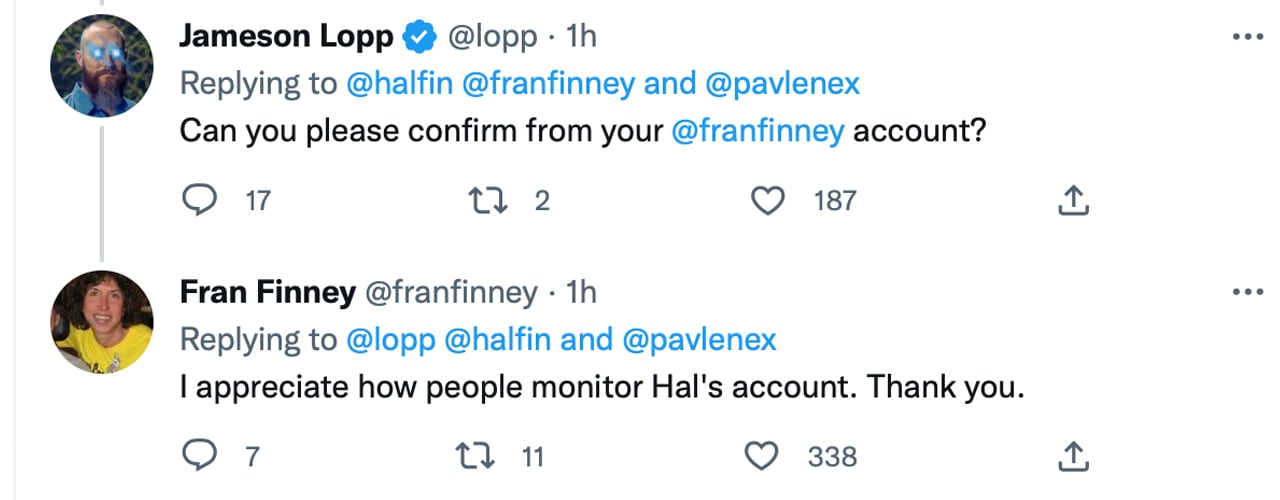Roughly seven days ago the owner of Twitter, Elon Musk, disclosed that the social media platform planned to purge 1.5 billion Twitter names if they were inactive or the accounts haven’t logged in for years. After the statement, bitcoiners grew concerned that the now-deceased computer scientist Hal Finney’s Twitter account would be terminated. It seems that since then, Finney’s wife Fran Finney has taken over Hal’s social media account in hopes Musk won’t purge her husbands account.
Fran Finney Has Control of Hal’s Twitter Account — Says She Activated It to Protect the Account From Elon Musk’s Inactive Twitter Account Purge
On Dec. 16, 2022, the bitcoin supporter Jameson Lopp tweeted an alert letting people know that Hal Finney’s Twitter account — @halfin — was now active. “ALERT,” Lopp said. “Someone has taken control of Hal’s Twitter account. Consider that we don’t know the intentions of the new owner; it could be compromised.” Lopp’s tweet got a reply from the @halfin Twitter account, which disclosed why Finney’s account was now active again.

“This is @franfinney. I am tweeting for Hal (as @pavlenex thought) to avoid his account being purged by Elon,” Finney’s account tweeted in response to Lopp’s tweet on Friday. Fran Finney, Hal’s wife, also confirmed from her personal account that she was the one behind activating the account after it wasn’t used since 2010.
“I appreciate how people monitor Hal’s account. Thank you,” Fran Finney’s account said to Lopp.
The news follows Elon Musk detailing that Twitter would remove 1.5 billion inactive Twitter names on Dec. 9. Following Musk’s statements, a great number of bitcoin supporters grew worried that Finney’s account would be purged and they begged him to preserve Finney’s account. Furthermore, there’s been some weird signings taking place as well as a Bitcointalk forum user named “Onesignature” signed a message associated with a block Finney had mined.
 Harold Finney II was a computer scientist known for being one of the first people to use the Bitcoin software when it was released by Satoshi Nakamoto in Jan. 2009. Finney was a well known cypherpunk before Bitcoin’s inception, and Finney developed a reusable proof-of-work (PoW) scheme in 2004, before Nakamoto introduced the distributed ledger system. In March 2013, Finney posted to bitcointalk.org and told people he was paralyzed due to amyotrophic lateral sclerosis (ALS) complications. The computer scientist passed away in August 28, 2014, but still worked on a project called “bcflick” up until his death.
Harold Finney II was a computer scientist known for being one of the first people to use the Bitcoin software when it was released by Satoshi Nakamoto in Jan. 2009. Finney was a well known cypherpunk before Bitcoin’s inception, and Finney developed a reusable proof-of-work (PoW) scheme in 2004, before Nakamoto introduced the distributed ledger system. In March 2013, Finney posted to bitcointalk.org and told people he was paralyzed due to amyotrophic lateral sclerosis (ALS) complications. The computer scientist passed away in August 28, 2014, but still worked on a project called “bcflick” up until his death.
Additionally, not too long after that odd signing event, the ‘pharma bro’ and former hedge fund manager Martin Shkreli shared a signed message associated with an address linked to Finney. The message was tied to the address Hal used to receive 10 BTC from Satoshi Nakamoto and the message said: “This Transaction was made by Paul Leroux to Hal Finney on January 12, 2009 #bitcoin.”
It’s not known if anyone has reached out to Fran Finney directly about these odd address signings and whether or not she knows why someone may have access to Hal’s private keys. Shkreli told the software developer Greg Maxwell that he planned to reach out to the Finneys to ask about the private keys. The controversial Shkreli, however, did not disclose how he obtained the message that used an old 2009 address with a message about Paul Le Roux.
Tags in this story
@halfin Twitter account, 1.5 billion accounts, 10 BTC, 2009, 2009 tweets, Block 9, block rewards, Computer Scientist, Elon Musk, Elon Musk’s purge, Fran Finney, Fran Finney activate, Hal Finney, Hal Finney’s Twitter account, Inactive Twitter accounts, Jan. 10 2009, running bitcoin, running bitcoin tweet, The @halfin account, Twitter, Twitter Account Preservation, twitter accounts
What do you think about Fran Finney taking over her husband’s account to protect it from Elon Musk’s purge? Let us know what you think about this subject in the comments section below.
![]()
Jamie Redman
Image Credits: Shutterstock, Pixabay, Wiki Commons
Disclaimer: This article is for informational purposes only. It is not a direct offer or solicitation of an offer to buy or sell, or a recommendation or endorsement of any products, services, or companies. Bitcoin.com does not provide investment, tax, legal, or accounting advice. Neither the company nor the author is responsible, directly or indirectly, for any damage or loss caused or alleged to be caused by or in connection with the use of or reliance on any content, goods or services mentioned in this article.


